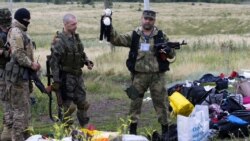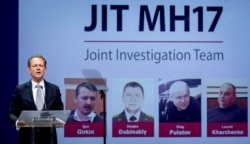The Dutch court will begin the MH17 hearings on March 9. Four men accused of shooting down the Malaysian Airlines flight on July 17, 2014 over eastern Ukraine, killing all 298 passengers and crew aboard, will be tried in absentia. Three are Russian citizens currently in Russia, whose military is the suspect in the crime. The fourth is a Ukrainian citizen whose whereabouts are currently unknown.
Ahead of the trial, Radio Free Europe/Radio Liberty released a video cataloging some of Russia’s attempts to muddy the waters about the crime, for which it categorically denies responsibility.
The video covers some of the “alternative” theories Russia has put forward in the five years since the crash – all of which fact-checked and proven false. These include the theory that a Ukrainian military plane or surface-to-air missile downed the airliner, as well as more bizarre ones. The latter include the theory that the plane was loaded with dead bodies and deliberately blown up over Ukraine in order to frame Russia, and another claiming that the Ukrainians downed the airliner after mistaking it for a flight carrying President Vladimir Putin back to Russia from a visit to Brazil.
The RFE/RL video also shows how many times Russian sources have contradicted their own previous theories with new ones.
Polygraph.info has tackled Russia’s numerous and varied MH17 denials, including its recent claim that leaked Dutch intelligence documents exonerate Russia. In fact, those leaked documents contradict earlier Russian Defense Ministry claims that MH17 was shot down by a Ukrainian Buk M1 surface-to-air (SAM) system.
As Polygraph.info has shown, Russian sources -- including from the Defense Ministry, state media, and even the manufacturer of the Buk M1 missile system responsible for downing the airliner -- have repeatedly put out theories that were not only quickly debunked, but often contradicted each other.
It is difficult to understand why Russia would deliberately put out numerous contradictory theories, some of which it quickly discarded only to float again later. In the RFE/RL video, researcher Nina Jankowicz, author of the book How to Lose the Information War, explains the strategy behind flooding the information space with different, competing theories.
“Russia’s main goal in putting out as many narratives as possible around MH17 is to confuse regular people, to say: ‘you know there actually is no knowable truth in this instance,’” she said. “So that allows Russia to, again, maintain an air of plausible deniability.”
Russia’s official organs have often released new alternative theories in an apparent response to new revelations from international investigations like the one that the Dutch-led Joint Investigation Team is conducting. With the trial of the three Russian and one Ukrainian suspects beginning on Mar. 9, Russia may produce additional alternative explanations, some of which will likely contradict their previous claims.
The four suspects to be tried are:
Igor Girkin, Russian citizen, former officer in Russia’s Federal Security Service (FSB), and former leader of Russia’s proxy forces in Ukraine, who once claimed responsibility for starting the war.
Oleg Pulatov, Russian citizen and former Special Forces operator for Russia’s GRU (military intelligence). Pulatov headed a department of military intelligence for the self-proclaimed “Donetsk People’s Republic” (DNR), the Russian-backed pseudo-state in eastern Ukraine.
Sergei Dubinsky, Russian citizen and GRU operative. Dubinsky allegedly headed the DNR’s military intelligence agency at the time of the MH17 disaster.
Leonid Kharchenko, a Ukrainian citizen who headed a reconnaissance battalion fighting for Russia in 2014.Kharchenko’s unit served Pulatov’s DNR military intelligence department during the war. He is accused of helping move the SAM system that shot down MH17 from Russia into Ukraine. After MH17 was shot down, the missile system was transported back into Russia.
The four men are charged with causing the MH17 disaster and the murder of its 298 passengers.
Last year, Ukrainian commandos captured another Ukrainian suspect in the case, Volodymyr Tsemakh, during a behind-the-lines raid. Tsemakh was later released in a prisoner exchange brokered with Russia. Tsemakh was suspected of involvement in hiding and evacuating the Russian Buk M1 SAM system that shot down MH17.
For more about MH17 and the evidence of Russian complicity, we recommend the following fact-checks:
“Putin Says Russia Never Shirks Responsibility, Denies MH17 Evidence”
“Sputnik Repeats Russia's False Tales About MH 17, Four Years Later”








